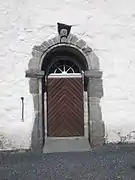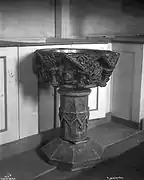Fjære Church
Fjære Church (Norwegian: Fjære kirke) is a parish church of the Church of Norway in Grimstad Municipality in Agder county, Norway. It is located in the village of Fjære. It is the main church for the Fjære parish which is part of the Vest-Nedenes prosti (deanery) in the Diocese of Agder og Telemark. The white, stone church was built in a long church design around the year 1150 using plans drawn up by an unknown architect. The church seats about 300 people.[1][2]
| Fjære Church | |
|---|---|
| Fjære kirke | |
 View of the church | |

| |
| 58.3662°N 08.5947°E | |
| Location | Grimstad Municipality, Agder |
| Country | Norway |
| Denomination | Church of Norway |
| Previous denomination | Catholic Church |
| Churchmanship | Evangelical Lutheran |
| History | |
| Status | Parish church |
| Founded | Bef 12th century |
| Consecrated | c. 1150 |
| Architecture | |
| Functional status | Active |
| Architectural type | Long church |
| Completed | c. 1150 |
| Specifications | |
| Capacity | 300 |
| Materials | Stone |
| Administration | |
| Parish | Fjære |
| Deanery | Vest-Nedenes prosti |
| Diocese | Agder og Telemark |
| Type | Church |
| Status | Automatically protected |
| ID | 84152 |
History
The earliest existing historical records of the church date back to the year 1320, but the church was not new that year. The first church at Fjære was likely a wooden church with a stone altar. That church was taken down at some point an replaced with the present church, likely around the year 1150, but the old stone altar from the old church was left in place and a new stone church was constructed on the same site surrounding the existing altar. The new church had a 18-by-12-metre (59 ft × 39 ft) rectangular nave with an 8-by-10-metre (26 ft × 33 ft) rectangular choir on the east end. There was a semi-circular apse built on the eastern end of the choir as well. The church was constructed with a basement crypt underneath it. (The crypt contains 26 bodies, mainly important people from the community during the 17th century. The basement was formally closed to visitors in 1997 to give respect to the dead.)[3][4]
The church was essentially the same from the early 1300s until the 1600s when changes were undertaken. First, the roof structure was changed, and the church got a flat ceiling and a new attic floor. Since then, the number of seats has been increased by adding balcony seating areas. During the 18th century, the apse had settlement damage, and the roof there was torn down and the apse was rebuilt along with a wooden sacristy on the east side of it. Around 1745 the gallery along the north wall was extended to the choir. In 1827, a large wooden tower was built on the west end of the building. In 1898, the west gallery was expanded to accommodate the organ. In the 1930s, plans were made to renovate and restore the old church. These got interrupted by the German invasion of Norway and the ensuing period of war. The restoration was finished during the 1950s and 1960s. When it was all finished, they had removed the old sacristy in the east and a larger sacristy was built on the north side of the nave. The foundations were all fixed to correct the sagging and skewed walls within the building. Frescoes were uncovered on the walls at this time as well.[3][4]
Terje Vigen
The local poet and writer, Henrik Ibsen, wrote a poem about Terje Vigen in 1861. The poem talks about Fjære Church where Terje Vigen is buried. There is a large obelisk in the churchyard remembering Vigen and others who died during that war in 1807–1809.
Media gallery
 Exterior side view
Exterior side view Front view
Front view Rear view
Rear view Rear view
Rear view Obelisk remembering Terje Vigen and other war dead
Obelisk remembering Terje Vigen and other war dead Side entrance
Side entrance Interior view
Interior view Looking towards the altar
Looking towards the altar Balconies
Balconies Altar
Altar Pulpit
Pulpit Baptismal font
Baptismal font
References
- "Fjære kirke". Kirkesøk: Kirkebyggdatabasen. Retrieved 16 January 2021.
- "Oversikt over Nåværende Kirker" (in Norwegian). KirkeKonsulenten.no. Retrieved 16 January 2021.
- "Fjære kirkested" (in Norwegian). Norwegian Directorate for Cultural Heritage. Retrieved 17 January 2021.
- "Fjære kirke". Norges-Kirker.no (in Norwegian). Retrieved 17 January 2021.